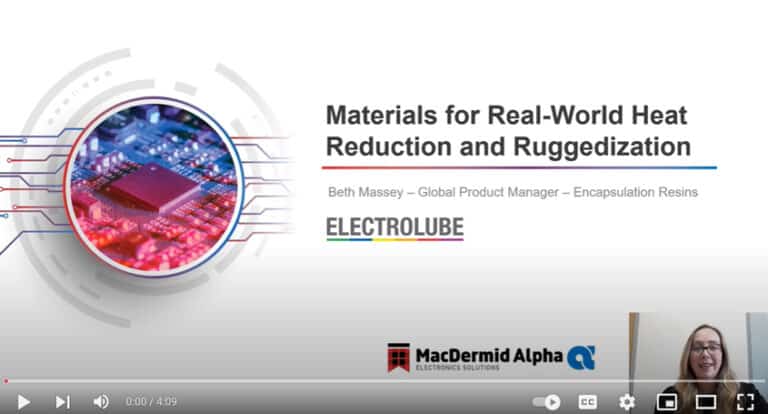So, my Technical Support Team and I were at Electronica in Munich last week, speaking directly with customers, answering questions and finding solutions to their problems.
On the Thermal Management stand (my base for the week) there are some common themes running through the questions that we are receiving.  So I thought I would share them via our knowledge centre for everyone’s reference:
So I thought I would share them via our knowledge centre for everyone’s reference:
“What thickness should I apply my thermal interface material?”
Whether it’s a thermal management paste, gap pad or phase change material, the question still stands, and what a simple question it appears to be…….
However, after a few minutes discussion with most customers, it is almost always evident that this is not the straightforward scenario that it initially appeared to be.
Of course, we can advise customers on the ‘ideal’ applications and how we would like our thermal interface materials to be applied but we are realistic, it is not always possible to meet these requirements. In real life situations, contact surfaces vary, as do contact pressures. The most important thing is to ensure that there is not air trapped at the interface.
Air is a poor conductor of heat, if you have air entrapment, (even a microscopic amount) at the interface due to poorly mating surfaces, inaccurate application of a thermal interface medium or larger gaps than calculated, the efficiency of thermal transfer is sure to be reduced.

“But you have a TDS, a specification, why does it not contain the minimum thickness required for efficient heat transfer?”
Why?.. Well, the answer to that question is much easier, because no two application contact surfaces are the same.
As we have mentioned in the first point, every application will be different and no two surfaces requiring a thermal interface material are the same. For example, if you take two electric motors, one may power something like a small refrigeration unit, whereas another application may be a large wind turbine; due to the scales involved alone, the minimum amount of material would vary, as would the smoothness of the contact surface and therefore thickness required. It is also necessary to take into consideration that the two projects will have very different measures of acceptable operating temperatures and therefore the required temperature transfer.
So how do we draw any conclusions on the correct application thickness?
Once we’ve eliminated any air inclusion, what’s next? – Trying to find the best method of application.
We need to be sure that the thermal interface material is applied in a thin, even layer. This layer should be as thin as possible whilst still ensuring full surface contact.
With each material, the application techniques will vary, but ideally, the thermal interface material should conform to the contours of the two mating surfaces. In most applications, it is preferable to use thermal pastes or phase change materials for this reason as these will offer more complete coverage than a thermal pad, but again – as is the theme here, it will vary between each application.
By using a material that is adaptable to the surfaces it is applied to, it ensures that the minimum amount of material can be applied whilst still eliminating all air from the interface. In turn, this ensures maximum efficiency.

“We are using a thermally conductive material though, why does it need to be applied thinly?”
In most cases the thermal interface material will be electrically insulating, avoiding any issues with the performance of the PCB. Because the materials are electrically insulating, metal oxides are often used as the thermally conductive medium and as a result, the thermal conductivity of the interface material is massively lower than that of the solid metal heat sink.
This means that as such, the thickness of the thermal interface material becomes the rate determining step; the thicker it is applied above the minimum amount required, the slower the rate of heat transfer.

“So, the thermal interface material I need is the one with the highest thermal conductivity?”
If you compare two products on paper by looking solely at the TDS, many people assume that the product with the highest thermal conductivity value will be the best product for the job.
In fact, most customers after a little discussion about the application conditions will discover that their initial specification is much higher than is actually required.
While the TDS can give you a ball-park idea of what you may want to use, really you should look at what you need to achieve, and the other contributing factors and ultimately – test the product.
In the vast majority of projects I have spoken with customers about over the last few months, the end product chosen has needed a far lower value than first specified.
“So how should I apply my thermal interface material to get the best results?”
Thermal interface materials can be applied using a variety of methods, both automatic and manual methods. In all cases, less is more and so the key to efficient thermal management is simple; understand your contact surfaces and have a play, see what quantity or thickness of a thermal interface material is needed to just fill the gaps at the interface and remove the air.
So – what should I take away as the key points to remember?
The most important thing of all to remember is that every application is different, so you should never rely solely on the TDS to choose a product, or to compare two ‘like for like’ materials.
Secondly, removing all air is key, ensuring the interface material is uniform and doing so by applying just enough to achieve these parameters.
Finally – Talk to us! We have a global Technical Support Team who are on hand to help and guide you to the correct product and by extension the easiest application method for that product; our goal is to ensure a streamlined production process and provision of efficient heat transfer both in initial application and final use.
Keep the questions coming, we enjoy discussing your applications and trust us, the so-called ‘simple questions’ are always the best!










